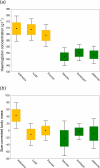Urbanization enhances body condition, but not innate immune defences, in a common waterbird
- PMID: 39816743
- PMCID: PMC11732394
- DOI: 10.1098/rsos.241062
Urbanization enhances body condition, but not innate immune defences, in a common waterbird
Abstract
There is a growing body of evidence that urbanization can affect body condition and immune function in wild birds, although these effects may be complex and taxa-specific. Here, we assessed the effects of urbanization on body condition (size-corrected body mass and haemoglobin concentration) and innate immune defences (haemolysis-haemagglutination assay, haptoglobin concentration and bacterial killing assay) in 136 Eurasian coots (Fulica atra) from three urban and three non-urban populations across Poland. We also quantified the heterophil to lymphocyte ratio to control for the potential effect of physiological stress on immune defences. We found that urban coots showed significantly better condition than non-urban ones. At the same time, we found no relationship between any immune defence and urbanization or condition. Thus, our study offers no support for condition-dependent immune function. Our analyses also revealed significant differences between male and female coots in both condition and immune defences; however, we found no evidence for sex-specific responses to urbanization. In conclusion, our study provides correlative evidence that urban habitat enhances condition, but not immune defences in the Eurasian coot.
Keywords: Eurasian coot; birds; health; innate immunity; urban-rural.
© 2025 The Authors.
Conflict of interest statement
We declare we have no competing interests.
Figures




References
-
- Antrop M. 2004. Landscape change and the urbanization process in Europe. Landsc. Urban Plan. 67, 9–26. (10.1016/s0169-2046(03)00026-4) - DOI
-
- Seress G, Liker A. 2015. Habitat urbanization and its effects on birds. Acta Zool. Acad. Sci. Hung. 61, 373–408. (10.17109/azh.61.4.373.2015) - DOI
-
- Eötvös CB, Magura T, Lövei GL. 2018. A meta-analysis indicates reduced predation pressure with increasing urbanization. Landsc. Urban Plan. 180, 54–59. (10.1016/j.landurbplan.2018.08.010) - DOI
-
- Isaksson C. 2018. Impact of urbanization on birds. In Bird species: how they arise, modify and vanish (ed. Tietze DT), pp. 235–257. Cham, Switzerland: Springer.
Associated data
LinkOut - more resources
Full Text Sources

